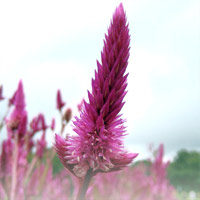Technicolor Flowers
Amaranths Add a Bounty of Colors to Your Garden
With names like joyweed, bloodleaf, Prince’s feather, Joseph’s coat, tassel flower, and even love-lies-bleeding, these plants must be colorful as all get out. In fact, they are. All of them belong to the same interesting plant family, the amaranthaceae.
Joyweed (Alternanthera tenella) is a very colorful foliage plant that is native from Mexico to Argentina. While it is not large—only growing to a foot or so in height—it is certainly bright. Both leaves and stems are beet red. There are some selections with alternate color schemes: ‘Bettzickiana’ has leaves blotched with red and yellow, and there are two others, ‘Parrot Feather’ and ‘Versicolor’, that have green leaves with yellow markings and pink veins. You may also find a dwarf and more bronze form called ‘Magnifica’.

For warm zones, bloodleaf (Iresine species) also has fancy foliage that can thrive outdoors. Unlike some of the other members of this family whose inflorescences provide a lot of the interest, flowers of these species are inconspicuous; their foliage more than makes up for this lack. The most common in area nurseries is I. herbstii with variable leaf colors from pinkish purple leaves and a lighter mid vein or bronze-green leaves and yellow veins. Stems also do their part and range in color from green through red and purple. At one to three feet in height, grow bloodleaf (and joyweed) as border plants or compile colorful container gardens with them.
The family namesake genus amaranth contains much variation. The ornamental ones are sometimes wild and even wacky. Amaranthus caudatus, also known as love-lies-bleeding or tassel flower, is moderately ornamental and a great curiosity. The foliage is rather coarse, and the plants can actually reach up to eight feet in height. The tiny red flowers are born in profusion on long stalks that arch and droop. An additional reason to grow this species is to harvest the fine seeds as an alternative to other cereal grains. There are a couple of selections that have a bit more personality. The graceful flower stalks on ‘Pony Tails’ are shades of red and green, while the upright stalks of ‘Fat Spike’ are just that, in an intense shade of red. ‘Coral Fountain’ is exactly what its name implies, and the flower stalks of ‘Dreadlocks’ are clubbed and twisted. Another edible amaranth is Prince’s feather (A. hypochondriacus). Its reddish leaves can be cooked and eaten just like spinach, which also belongs to this family, and the flowers yield nutritious seeds just as tassel flower does.
The most handsome of the amaranths is Joseph’s coat (A. tricolor). Named for the multicolored coat that the Biblical Joseph wore, its leaves are blotched in shades of red and green. There are several selections with different color schemes. The best known is called ‘Joseph’s Coat’ and has green, brilliant red, and bright yellow zones on its leaves. The names of other cultivars tell the tale. ‘Flaming Fountain’ and ‘Molten Fire’, for example, are obviously yellow and red.
Where are those purplish tones that joyweed sports? Amaranthus hybridus ‘Intense Purple’ should fill the bill. It has deep-purple leaves with reddish-purple stems and flower tassels up to four feet in height. For another version, the annual A. paniculata ‘Marvel Bronze’ has dull purple foliage topped by short, erect plumes of deep red flowers. If all this intense color is not to your fancy, there is another, more demure, amaranth. This one is also a selection of A. paniculata, and seeds are sold under the name ‘Autumn Palette’. Still showing the habit of towering four to six feet in height, the green foliage is topped by upright spikes of cream and orange.
One more amaranth family relative is Gomphrena, or globe amaranth. This genus keeps the color palette cool with flower heads of white, pink, and lavender. Less forward in its form, it is also smaller and not so much in-your-face. While the species may grow to two feet, there are lots of more-dwarfed selections that may be only half that height. Flowers are clustered in more rounded heads. For bright red blooms, choose ‘Strawberry Fields’. For purple, pick ‘Buddy’ or try the white ‘Cissy’.
All these amaranth kin require and thrive in full sun, and a few may even survive as perennials here in our mild winter climate. Most are also moderately drought tolerant. A few selections may appear in nurseries as young plants in the coming months, but more are available as seeds. Most germinate easily, but at warm temperatures, so starting them in pots or flats indoors will ensure good results. Plant in sandy or well-drained soil for best result. Ready for some real flash and pizzazz? Plant one or more of these highly personable amaranths.



